Hello everyone:
First, I want to welcome new Field Guide readers, many of whom have arrived thanks to Bill Davison’s generous Substack Reads post. Take a walk through my archive, and make yourself at home. Contact me if you have questions or comments. You’ll find that my essays toggle between personal and research-driven explorations of the transformed world, between the beautiful world and all that threatens it, though each essay contains some of everything and all of my work tries to sing a little bit too.
I’m still busy working on a new edition of my old Antarctic book, and so this week I’m offering a (thoroughly rewritten) essay from a few years ago when the Field Guide was young and readers were still trickling in. The topic - fire in the Anthropocene - has only grown more relevant.
As always, please remember to scroll past the end of the essay to read some curated Anthropocene news.
Now on to this week’s writing:
In his review of Elizabeth Kolbert’s White Sky: the Nature of the Future, the extraordinary environmental historian Stephen Pyne said this about how humans move like wildfire through the natural world: “There are simply too many of us doing too much too quickly. We are a start-up species, a biotic Facebook – moving fast, breaking things, [and] hoarding ever more” of the planet’s resources.
As someone who wields my own poetic license once in a while, I appreciate how Pyne’s contemporary metaphor captures the speed and callousness of our rise to power here on Earth – “a biotic Facebook” – as well as the possibility of failure – “a start-up species” - as he describes our burgeoning population’s rapacious appetite and lack of regard for the community of life.
In the Anthropocene, we’ve entered what Pyne calls “a whole ecology of interacting crises” caused by human activity. I imagine his list includes erasure on a mass scale of habitats and ecosystems by agriculture, cities, and industry; decline of apex and keystone species across the globe; transformation of microbial life through antibiotics, farming, and eradication of wildlife; overfishing, acidification, and contamination of the oceans; and, hanging over all of this, our production of CO2 at an unprecedented rate.
I’m not prognosticating doom. I’m merely turning away from my screen here to walk outside and look at the world as it is. As most of you already know, and as I’ve often written, there’s good reason to believe we’ll rein in our worst habits and the worst impacts. All that clean energy coming online is a great start. And millions of good people (like those at the Center for Biological Diversity) are doing good work every day to hold the line against erasures and declines of plants and animals. But things will get worse before they get better. How much worse is up to us.
If, though, we are foolish enough to keep making the same mistakes this century that we made in the last two centuries, we’re on track to initiate a sixth mass extinction, perhaps unlike anything the planet has experienced in 250 million years.
If you’ve read anything about mass extinctions - and you should, in Peter Brannen’s marvelous The Ends of the World - this prospect should compel you to help turn the ship of civilization around immediately. Here’s Brannen from a brilliant 2021 article in the Atlantic, echoing Pyne on the astonishing speed of the Anthropocene. If you don’t mind some reading instruction, I suggest you read slowly to really feel the weight of it:
We are imposing a rate of change on the planet that has almost never happened before in geologic history, while largely preventing life on Earth from adjusting to that change.
Taking in the whole sweep of Earth’s history, now we see how unnatural, nightmarish, and profound our current experiment on the planet really is. A small population of our particular species of primate has, in only a few decades, unlocked a massive reservoir of old carbon slumbering in the Earth, gathering since the dawn of life, and set off on a global immolation of Earth’s history to power the modern world… If we keep going down this path for a geologic nanosecond longer, who knows what will happen? The next few fleeting moments are ours, but they will echo for hundreds of thousands, even millions, of years. This is one of the most important times to be alive in the history of life.
This is one of the most important times to be alive in the history of life. Note Brannen does not say “human history,” but “the history of life.” That is, or should be, mind-boggling.
We know, practically and intellectually, what needs to be done to stave off such a future - a new model for civilization, with clean energy sources and a new consumption paradigm - but there’s no roadmap either in human history or in the geological record. “Humans,” writes Kolbert in White Sky, “are producing no-analog climates, no-analog ecosystems, a whole no-analog future. … And so we face a no-analog predicament.”
So, a good rule of thumb at this point might be to stop moving fast and breaking things. But just as the tech companies believe they’re above ordinary obligations to society, humans still act as if we’re rightfully above the biological fray. We light up the night, convert vast landscapes into housing and food and fuel, reshape planetary chemistry and biology, extend our senses through the solar system, and increase our lifespan. If you don’t see the consequences - Pyne’s “ecology of interacting crises” - all this would seem like an unmitigated success.
Asking eight billion humans to rethink civilization is a little like asking the winning Super Bowl team to go back into the stadium and apologize for trampling the grass and then ask the crowd’s help to convert the field to a pollinator meadow.
My introduction to Pyne was through what I consider to be one of the finest books ever written about Antarctica. The Ice: A Journey to Antarctica is a dense read – it’s often the first book I think of when I hear the word “tome” – but it is masterful, scholarly, creative, and often poetic. Pyne covers the history of Antarctic exploration, governance, science (from glaciology to penguin biology), and the Antarctic landscape I fell in love with. A journey into landscape, from sea ice to glacier to ice cap, structures the entire book. Pyne takes us deeper and deeper into the ice, then leaves us there, awed. Here are a few samples of his prose:
“In a sense, scientific exploration has not simply revealed Antarctica but created it. Eliminate those expeditions sent for scientific purposes and Antarctica would be no better known than Pluto. Strip away scientific concepts and the scientific lexicon and one is left literally speechless before the continent.”
“There is more information in a single penguin than in all the polar plateau.”
“What began as an unknown white spot on the map of the known world would, paradoxically, end up as a known white spot.”
But I digress. (If anyone wants to talk about Antarctica, please start a thread in the Comments and I’ll be happy to digress some more.)
So let’s leave the ice and move on to fire, which has been Pyne’s career focus. One of the foremost scholars on the topic, most of his forty or so books have been about the history of fire and our relationship with it. His take on the Anthropocene is through a fiery lens, then, and for him a more appropriate name for this new epoch is the Pyrocene: an age of fire. “I have long regarded all of the Holocene as an Anthropocene,” he writes, and “from a fire perspective I now regard the Anthropocene as a Pyrocene.” Why? Because we are in “a Fire Age of comparable scale to the Ice Ages of the Pleistocene.”
At first glance his idea of a Fire Age might seem like a response to the horrific increase in the scale and intensity of wildfires around the world, and the likelihood in a hotter climate that these will become far worse and far more common. But Pyne’s thinking here runs much deeper, and begins hundreds of thousands of years ago.
First, he explains, in early human history we made a “pact” with fire. This arrangement gave us cooking, light at night, new hunting techniques, advanced tool-making, increased protection, and eventually the sophisticated landscape control practiced by Indigenous cultures across the globe. It’s worth thinking about the implications for cultural development that each of these provided.
Then came the industrial revolution. The complexity of our relationship to fire increased exponentially, and became existential. We began to burn not just botanical fuels found on the planet’s surface – plants, trees – but fuels (coal, oil, gas) excavated from deep underground and from deep time. In making the transition from using natural fire and controlled fire to inventing contained fire – internal combustion in all its myriad forms – humans and fire together transformed Earth.
“Whether that alliance is a mutual assistance pact or a Faustian bargain may be the question of our time,” Pyne says, largely because of the CO2 churned out by all that excess combustion. “Fire,” Pyne writes,
brought us power. We got small guts and big heads because we learned to cook food. We went to the top of the food chain because we learned to cook landscapes. Now we have become a geologic force because we have begun to cook the planet.
It had never occurred to me before reading Pyne that fire was a through-line of the Anthropocene, that we burned our way out of Eden and now we’ve burned our bridges back.
Our bargain with fire didn’t have to become so Faustian. Other cultures lived with a rational, small-scale use of fire until we eclipsed most of them in our metastasizing, fossil-fueled growth. And the cost of that growth isn’t just the toasty alligators-in-the-Arctic Eocene climate barreling toward us. All the rupturing and erasure of biodiversity in the Anthropocene can be linked to the machines, petrochemistry (e.g. plastics and artificial fertilizer), and population growth made possible by what we’ve hauled out of the Earth to burn.
In 2021, Pyne published The Pyrocene: How We Created An Age of Fire, and What Happens Next. It’s on my pile but I haven’t read it yet. Given what I’ve read elsewhere by him on the topic, it should be essential reading. For now, I’ll recommend two excellent older articles, a short 2019 book excerpt in Natural History (pdf download) and a 2020 essay at Yale e360. I suggest starting with the Natural History piece because it beautifully explains what fire is and means. Here’s a sample:
Earth burns now because it acquired life. Life in the oceans filled the atmosphere with oxygen. Life on land piled fuels. Lightning strikes, the occasional volcano, and the rare extraterrestrial impact then ignited fires.
People raised in urban and industrial societies tend to experience fire within built environments – contained in torches and hearths, or burning wild through structures. But the fundamental story of fire is how it burns in living landscapes, taking apart what photosynthesis puts together. It is an ecological process to which life must adapt, while biological evolution enables and shapes it in turn. Hurricanes and floods can occur without a particle of life present. Fire cannot. It more resembles a locust infestation than an ice storm.
The Yale e360 piece, “Our Burning Planet: Why We Must Learn to Live with Fire,” addresses the history and consequences of our changing relationship with fire in Pyne’s typical evocative prose:
We have too many bad fires – fires that kill people, burn towns, and trash valued landscapes. We have too few good ones – fires that enhance ecological integrity and hold fires within their historic ranges. At the same time, with the incessant burning of fossil fuels, we have too much combustion on the planet overall. How did fire’s presence on Earth become so deranged?
He goes on to answer his rhetorical question in fine detail, noting that “even climate history has become a sub-narrative of fire history,” and that as we slow and ideally stop our burning of fossil fuels, we will have no choice but to increase our burning of landscapes in healthy ways. How much? “A lot. And in perpetuity. Fire management is forever.”
There’s a lot to this, so you’ll have to dive in yourself to understand his really, really interesting perspective.
I’ll close then, on a glimpse ahead. Philosophically, he writes, humanity has “two grand narratives for fire,” the Promethean and the Primeval. The Primeval is our natural relationship with fire, whereas the Promethean describes where we are now. Prometheus stole fire from the gods to empower humans, and we’ve imagined ourselves as godlike ever since:
The Promethean speaks of fire as power, as something abstracted from its natural setting, perhaps by force, and then directed as human hand and mind wish. The Primeval speaks of fire as a companion on our journey, of humans as keystone species and stewards for reconciling fire with land. Our future and that of the Earth depend on which of these narrative paths we choose to follow.
I think of this dichotomy as akin to the distinction made by Daniel Quinn in Ishmael: we belong to the Earth, but have come to believe that the Earth belongs to us.
The narrative path ahead is existential. The story we tell ourselves about how to live is the story of the Earth to come. Like it or not, we’re the authors of the future of life on Earth. That’s what the Anthropocene means. From here on, we’re either writing a disaster tale or a saga of slow recovery from a fundamental civilizational error.
This is one of the most important times to be alive in the history of life.
That’s a lot to take in, or even believe. Speaking for myself, at least, there’s grief and sadness and anger when I think about it, and there’s a really strong desire to set it aside as I deal with an already busy daily life. Not to mention that the couch and the internet are calling…
But there’s good work to be done, and so here we go. We have to walk into the flames and save what can be saved.
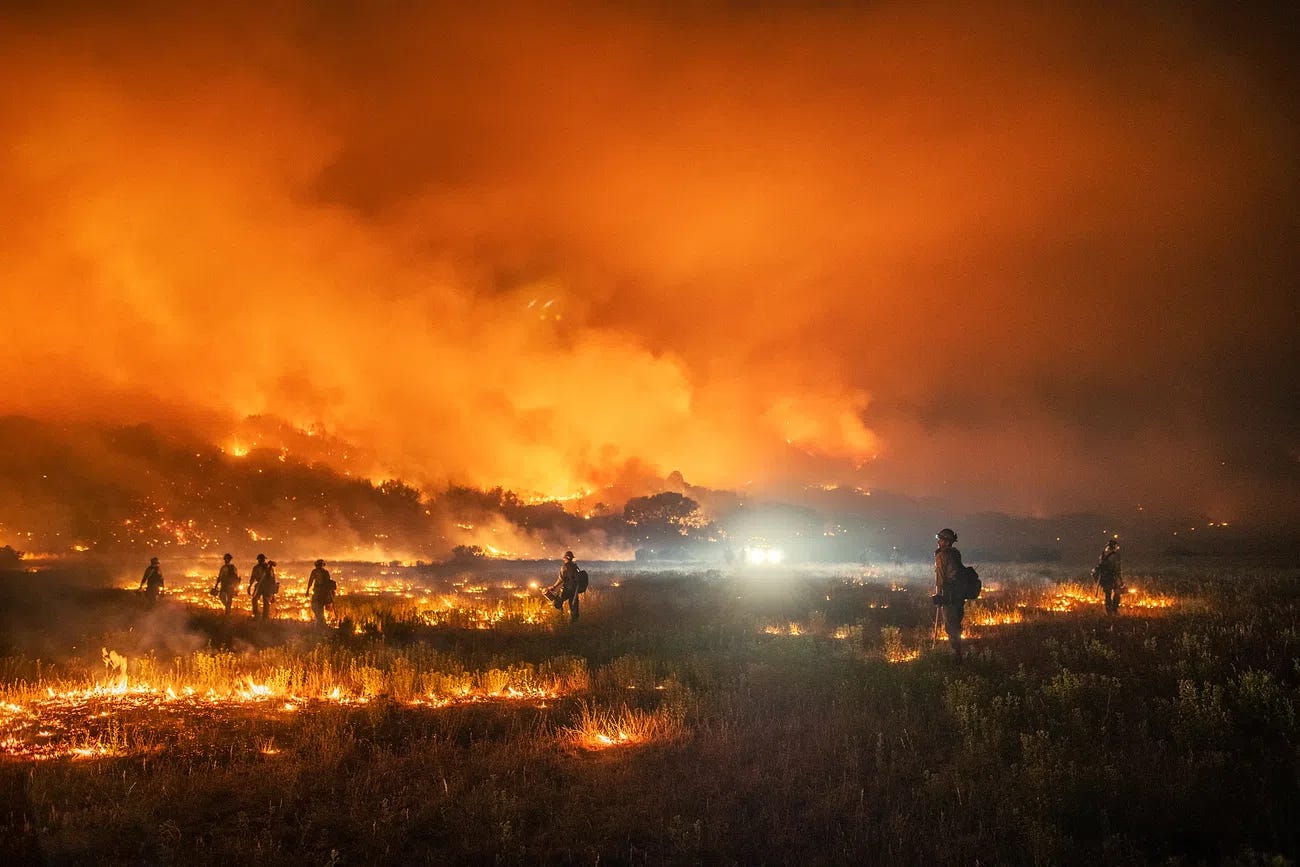
Thanks for sticking with me.
In other Anthropocene news:
In relevant news from Earth Hope, “Cut Some Trees to Save Our Forests,” as California burns former wildfire reporter Amanda Royal pleads with environmentalists to support wildfire prevention strategies, including not just prescribed burns but also logging. She makes a convincing, hard-earned case that we too often refuse to consider logging as an ethical approach to forest and fire management, given the often self-serving and rapacious habits of the logging industry. I have been one of the doubtful, but if she and the Nature Conservancy are on board, and if forest thinning is well-managed, then I’m on board too. Whatever your thoughts, read Royal’s piece.
From Vox, a good basic explainer on the significant decline in insect populations, a.k.a. the “insect apocalypse.” There’s much we don’t know, but we know enough to be very worried. My writing on the topic is “The Windshield Phenomenon.”
And in related news from the Times, how one couple managed, and is still managing, the transformation of their suburban lawn into a meadow. We can make a world of difference for pollinators and other insects if enough of us do this.
From Bullfrog Films, the trailer for “Single Use Planet,” a new documentary on the plastics crisis engulfing the world. The doc follows the trail upstream from ocean plastic pollution to the toxic manufacturing plants and finally to the political obstacles blocking a solution: money from industry and their lobbyists.
From BBC Future Planet, the delightful and necessary task of “re-wiggling” streams and rivers, i.e. restoring the natural curves that were straightened by farms looking to convert more riparian habitat to cropland. Doing so drastically and quickly improves habitat both in and alongside the waters:
After Swindale Beck was straightened the results were "mind blowing", says Annabel Rushton, the visitor experience manager at Wild Haweswater. "A lot of nature conservation is a long game. You plant a tree, you're not going to in your lifetime see that it reached its full potential. But within three months of that river being re-wiggled the salmon were spawning in that one kilometre stretch for the first time in over 150 years," she says.
From the Times, an excellent essay on the future of meat consumption, including the early steps toward the mass production of animal-less meat.



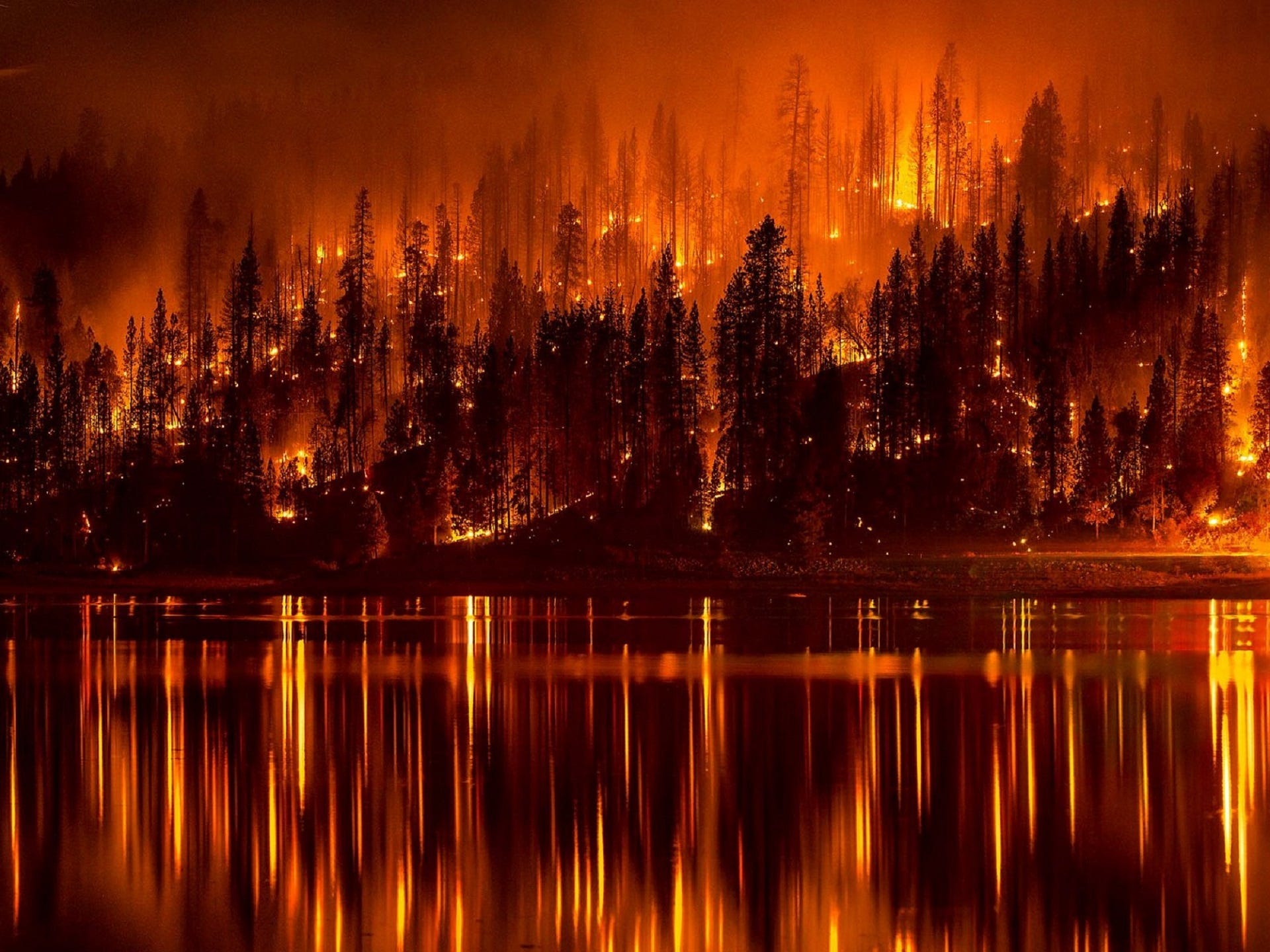

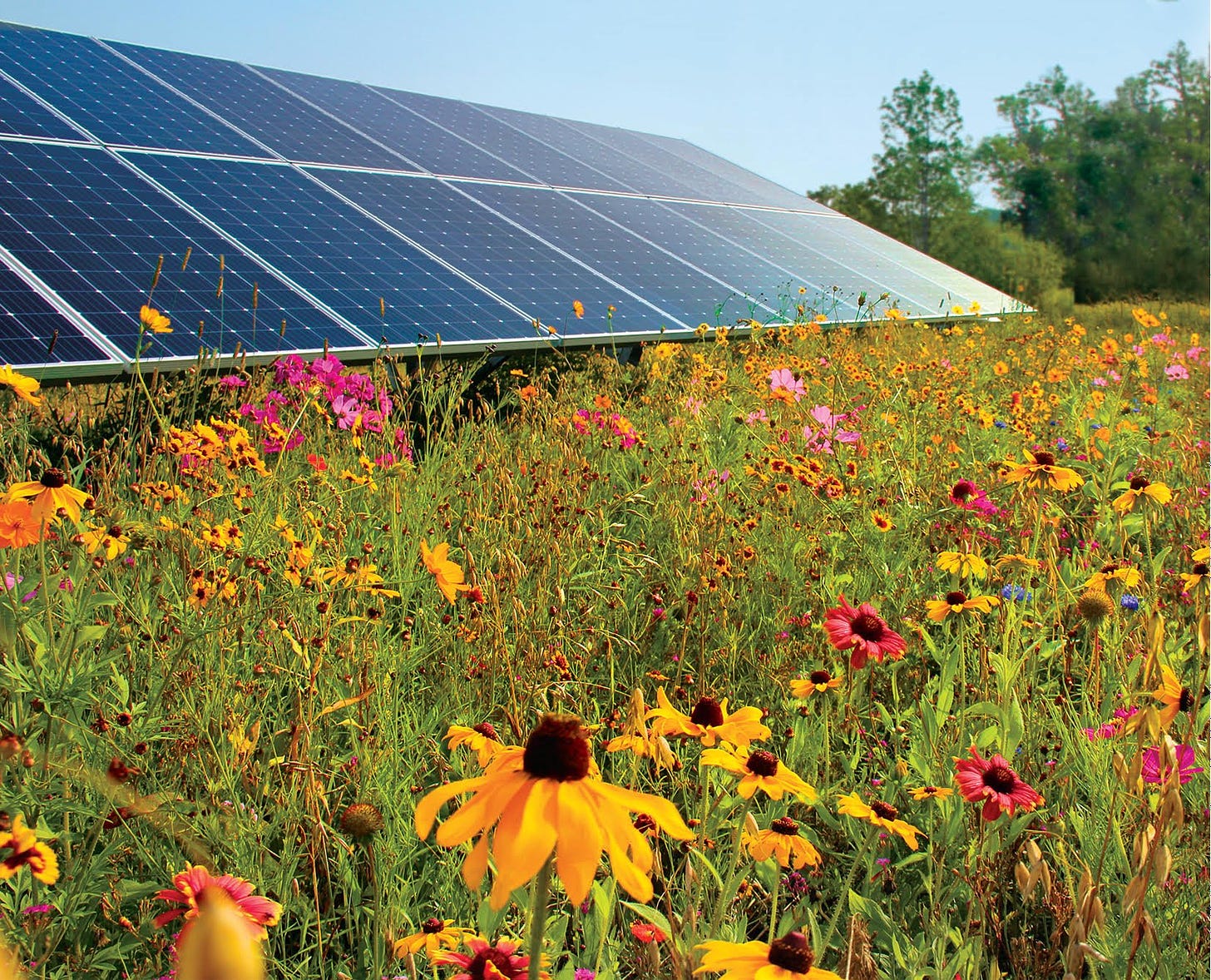
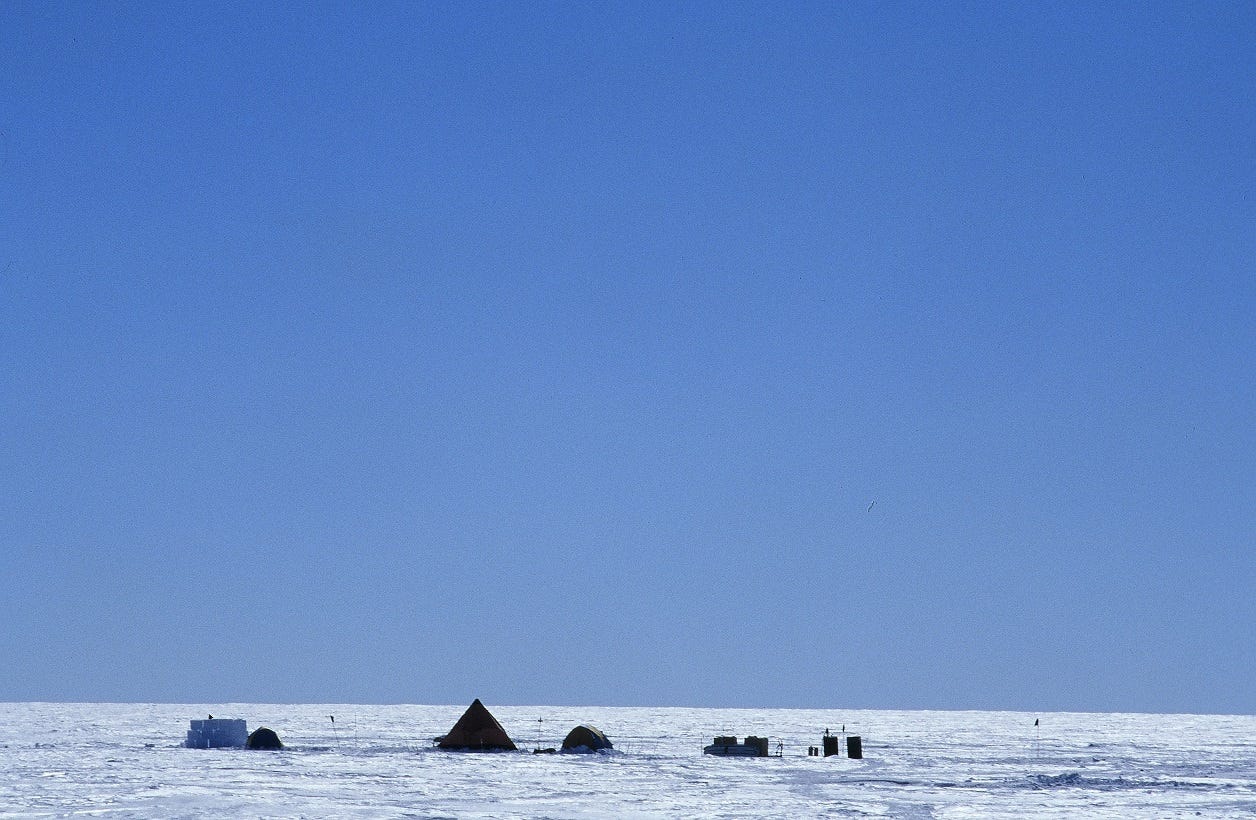
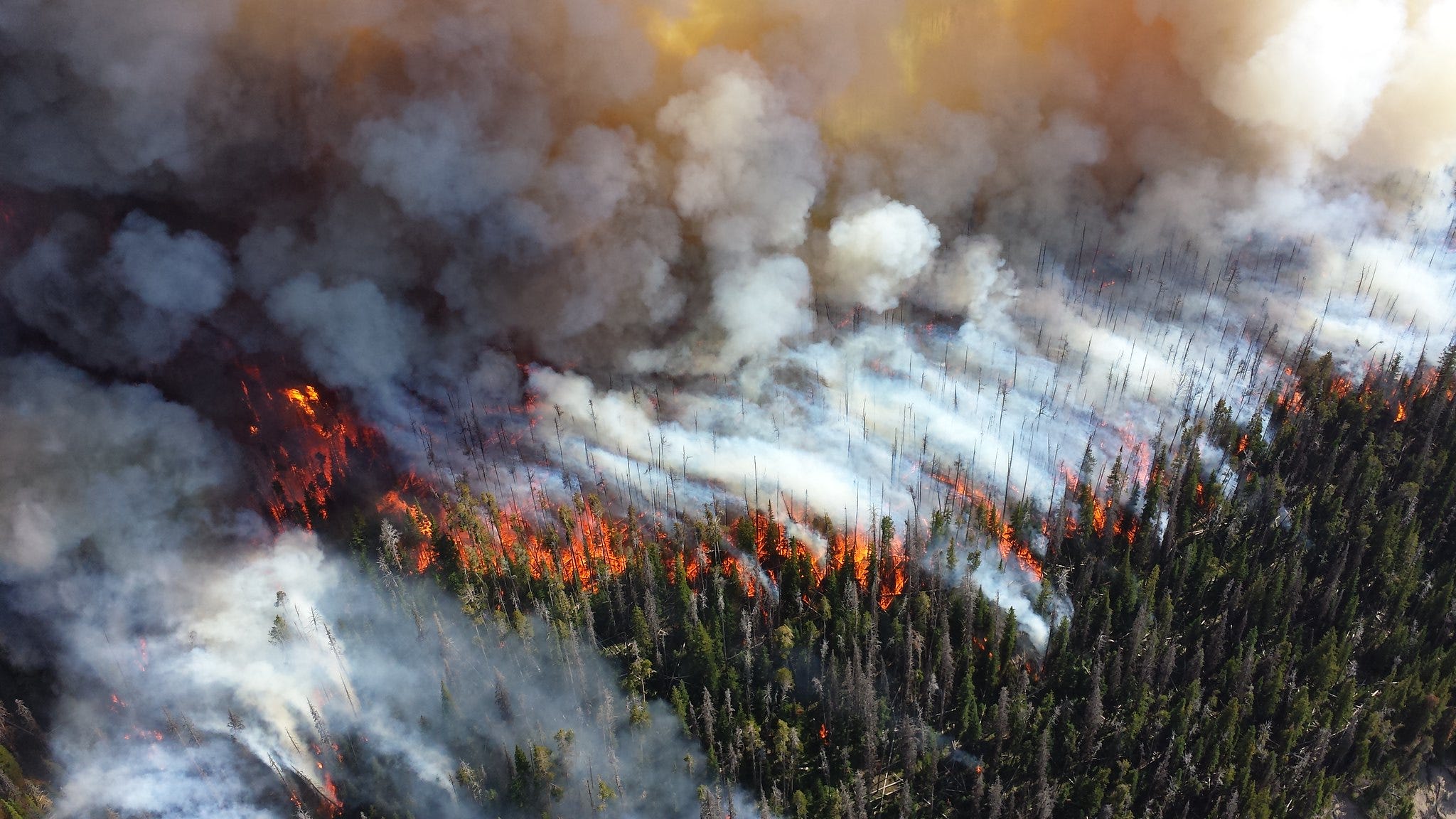

Great piece! There’s a lot covered here but in an interesting way. I couldn’t agree more with the caption on the solar meadow photo: “all climate solutions should also be biodiversity solutions”. I write a lot about this in my newsletter.
I have all the books you mentioned except yours. Get the new edition out when you have the time! I think you're one of the best writers on Substack and that's saying something.
I won't indulge myself with one of my jeremiads but to say, here in the greater Yellowstone bioregion where I currently am, we are experiencing record breaking heat, there are fewer birds than I can remember from 50+ years of coming here, and there are so many dead animals on the sides of roads, struck by vehicles,that I am constantly saying prayers for them. Usually coming back home here is joyous, but this year there is a cloud.
There is an ongoing tragedy and I feel the proper theme music for the Pyrocene, the Petrocene, the Anthropocene is Mozart's Requiem Mass.